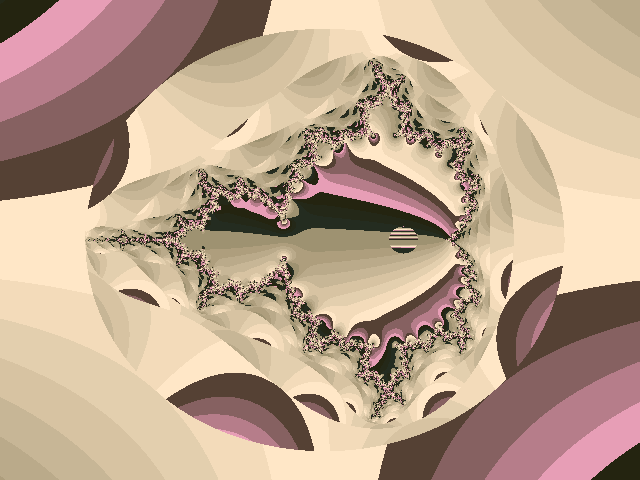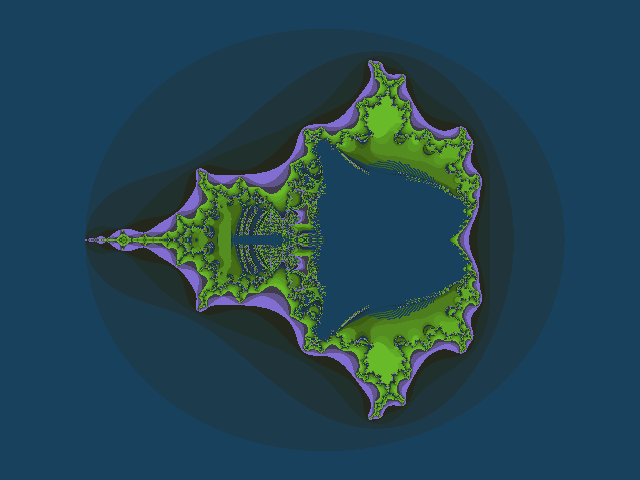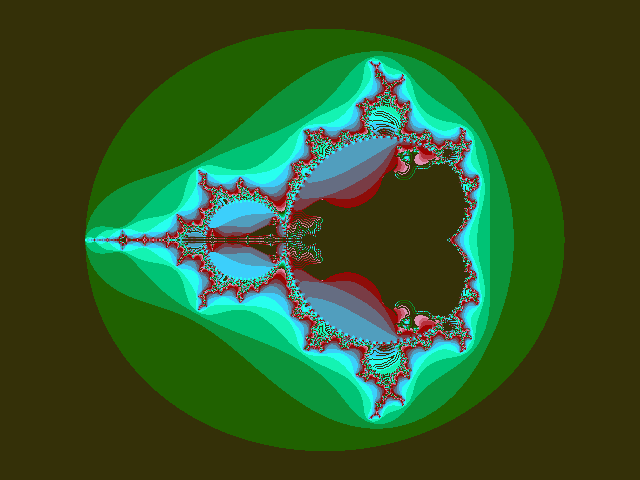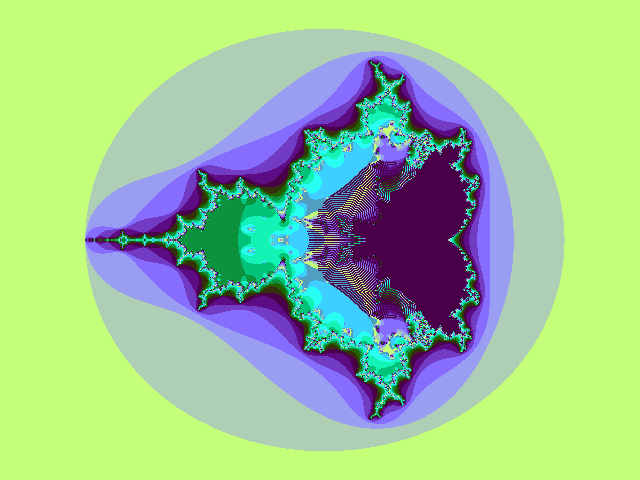
ISSN 0964-5640
And Innovative Computer Applications
Fractal Report to Cease Publication - Editorial
Interesting Ways of Filling the Interior of the Mandelbrot Set Jose Marques
Part 2
Fractal Report is published by Reeves Telecommunications Laboratories,
West Towan House, Porthtowan, Truro, Cornwall TR4 8AX, United Kingdom.
Internet: [email protected]
Volume 8 no 44 First published December 1996. ISSN 0964-5640
Editorial
This issue of Fractal Report is the be the last. Readers with standing orders are asked to cancel them immediately. Any standing orders not cancelled will be cause their owners to be charged a 5 processing fee for refunds - you have been warned.
The reason for the ending of the journal is that there is now no longer a varied enough range of people willing to contribute. Many of the articles in this volume are by Roger Bagula and Malcolm Lichtenstein. I am sure that most of us are grateful for the contributions of these people, but you can just as easily get access to their work by subscribing to The Fractal Translight Newsletter. This costs $20 in the USA and $50 elsewhere. Write to Roger L. Bagula, 11759 Waterhill Road, Lakeside, CA 92040, USA.
Fractal Report was originally intended to be a forum for varied articles and a platform from which most people could get published without hassle. If what they had written was foolish, then it was on their heads! Sometimes an apparently foolish idea would spark of some creative thought in others, so I felt that a platform was worthwhile.
Some allegedly impossible things were achieved during the years of Fractal Report. A tree growing program for the Sinclair Spectrum, and BASIC routines to run PC sound cards are a couple of examples. We never managed to get patterns from pi, and those from DNA were not particularly inspiring. The types of fractals seemed limited to mappings, IFS and iterating to a limit types. Mandelbrot and Julia sets of course seem obvious to us now, and maybe there are fundamentally different types of algorithms waiting to be discovered. But some years have passed in which there has been no fundamental new type emerging.
Fractal flybys on the desktop, and 3D fractals, we were told, would have to wait for much more powerful machines to appear. The machines are here, but the fractals are not, at least not in the form that is easily typed in with a few lines of BASIC. Also the new computers are being supplied with Windows 95 are not even coming with any form of programming language, although Visual Basic is not that expensive in its standard form. Originally PCs were supplied with GW BASIC or QBASIC, although I would guess that few users knew it was there.
However next year Intel plan to introduce new processors that have extra commands for 3D (presumably drawing 3D objects in perspective on the 2D screen). Maybe that will change things, but it could be some months before BASICS appear that use them and programming information may be hard and expensive to get hold of.
Most people capable of experimenting will also have access to the Internet, and there is a lively news group <sci.fractals> which can be a forum for your ideas. Cost is not a major handicap these days, with most places in the world having some form of local call access. About 500 news messages and up to 40 email messages can be downloaded with a 28.8k baud modem in about three minutes. No one can legitimately complain about three minutes local call per day. And we are told that modems of 56k baud will soon be available next year, with the potential to halve your connect time.
In order to read the world wide web you have to be connected while you read, which is more expensive. However there are many fractals sites, many of which have software available to download. These sites will give you flybys and 3D "monsters" and whatever else the future holds for fractals. You won't have to type anything in, which has its downside - you won't be able to modify the code at all. But most people are short of time, and just the chance to fly your own path through the Mandelbrot set or create a monster from your own parameters in a few seconds will be reward enough.
If there is sufficient demand, there may be irregularly produced HTML only version of Fractal Report on the world wide web.
(you're reading it!)
Back Numbers
Some volumes of Fractal Report, produced in the days I used a printing company, are available in quantity, and I am making a special offer of back numbers from the following list:
These issues are paper only. The are unlikely ever to appear in HTML format.
Issues 0 to 31 less issues 8,9,10,11,12 - as detailed below
These were offered as printed at varying prices between 50 and 100 approximately. I am now offering this entire set for 20 (payable to <RTL>)or $32 (payable to <J. de Rivaz>) including surface post at your risk anywhere. Add 6 or $9.60 for airmail.
This is a very substantial discount and the offer closes with the postal delivery on Friday, 31 January 1997.
Issue 0
includes a general essay on fractals From Star Trek to the Stiperstones Ridge by Mark Datko, Random Generation of Fractals by John Sharp (including a short GW BASIC program), Enhancing Mandelbrot Fractals by Larry Cobb (including a low cost program disc offer for PCs), Mandelbrot Generators on the Macintosh II by Mark Datko, (offering PD software) Fractals Maths and Graphics by Simon Goodwin (enlarging on the short program published overleaf), and more.
Issue 1
includes an important article by Dr Dietmar Saupe, editor of Science of Fractal Images, on speeding Mandelbrot images. A page of contacts and notices is followed by a short program and article Day's Squares. Fractals from the Solution of z^n=1 and z Trajectories make up the issue, together with two further Mandelbrot articles.
Issue 2
includes many articles with practical program examples such as Affine Transformations, by Dr Keith Wood, plus A Variation on the Mandelbrot Set, Melting Mandelbrots, A short Mandelbrot program for the BBC B, Computing Julia Sets in C, The Consequences of Finite Arithmetic, A Space filling Curve, details of the first Larry Cobb awards, and more.
Issue 3
ventures into the fourth dimension with Dr Entwistle's Quaternion Julia Sets, and continues in similar vein with Mark Datko's Faking Planets and Mark McCall's Warp Speed Mandelbrot Sets. There are More Affine Transformations from Keith Wood, and Dr Jules Verschuren provides More About Ineration Algorithms. John C. Topham finishes with some excellent Pictures from Dynamic Systems on his QL.
Issue 4
gives those unfamiliar with Henon Maps a chance to catch up, and also some short simple Mandelbrot and Julia plotters. There are a number of software offers, such as 68000 Mandelbrot and Julia plotters all in machine code for QL and Amiga, and also some shareware for various machines. A Star Fractal program and other short items makes this a useful issue for those just starting.
Issue 5
has as its main article a discussion of 3D images, and shows how just two lines added to the familiar Mandelbrot program can give a perspective view. Fractal Landscapes in C are also covered, with further news of the Larry Cobb prize. The use of the 8087 PC co-processor in Mandelbrot images is discussed in the final article.
Issue 6
has High Powered Mandelbroids, with examples. The Numbers Game and Speed, Mandelbrot and the Archimedes discuss the merits of various machines for quick fractal displays. Some Fractal Art illustrated advertisements, and coverage of The Henon Attractor and Further Investigations of a Chaotic Dynamical System follow. YAMS - Yet Another Mandelbrot Speed-up, The Third Larry T. Cobb Prize Awards, and a review of Dynamical Systems and Fractals concludes the issue.
Issue 7
starts with Pictures from Complex Polynomials using Newton's Algorithm. This is followed by A Three Dimensional Julia Plot with Z-Trajectories, which brings together some of the ideas in the first seven issues, showing how they can be used in a short BASIC program to produce a spectacular display that is interesting to watch as it builds up. Space Filling Iterative Patterns and the Ikeda Map follow. The issue concludes with Coloured IFS Tilings from our first Eastern Europe contributor, and an imaginative article on Intersecting Universes with some practical ideas.
Issue 13
is unusual in that it offers some longer articles. We expect to go back to the usual format with no 14. Further Fractals From Newton's Formula by John C. Topham is a long but usual format article, with plenty of illustrations. More Mandelbrot Sets by Chris Sangwin is a standard Fractal Report article, but most of the issue is taken up with Compressing Fractal Images by Mike Parker. This will be of use to those originating fractal programs, and it is hoped that those readers who find this a bit heavy will benefit eventually from some useful products being developed from it.
Issue 14
Back to the usual formula with The Sierpinski Curve by E.J. Turl. In A Bit More Detail Please Graham Johnstone expands on an idea in The Science of Fractal Images. José E. Murciano gives a program in Spanish that prints landscapes, and E.J. Turl returns to discuss The Volterra Lotka System. John Topham gives his usual detailed analysis, returning to the Bifurcation Diagram and Chebyshev Polynomials. Fractal Shareware for the Archimedes and some full page prints follow, and the issue ends with another program by José Murciano and the usual editorial and announcements.
Issue 15
Julia Sets: Alternative Mappings is another of Dr Ian Entwistle's excellent articles with code. Faster and Nicer Fractal Sets - Part 2 by Dr Jules Vereschueren continues another popular series. A Fractal Tiling is a first article by Italian reader Tiziano Terranova. Möbius Mandelbrot Contortions by Cade Roux ends the issue.
Issue 16
A long article on the Reimann Sphere by Roger Castle-Smith starts this issue. This should be of value to those interested in those arty projections. Another look at Mandelbrot Type Images From Newton's Method by John C. Topham and his trusty QL shows just what good results people with patience can achieve with almost any computer. Joyce Haslam uncovers the secrets of Ushiki's Phoenix for all to see and program into their computers. Finally Yvan Bozzonetti philosophises on What is Fractals Space.
Issue 17
starts with some Fractal Landscapes from Peter Berryman. Joyce Haslam turns up Inside the Julia Set, and John Topham provides some Fractals from Laguerre's Method. Howard Jones tells us how to make photographs from the computer screen. There are also articles on The Method of Double Precision, and Fractals from any Polynomial Using Newton's Method and a Biomorph program.
Issue 18
has more Julia sets: Mappings with decomposition from Dr Ian Entwistle. An important series by John Sharp Chaos in New Clothes starts, and Dick Oliver discusses Fractals and Being Human. Chris Sangwin finishes with The Blancmange.
Issue 19
Images from Halley's Method John Topham Rabbits and Foxes Dolores Garcia Garcia L - Systems John Sharp Double Position for Functions of a Complex Variable Paul Gailiunas Taking Photographs of Computer Screen Images Using Focal Plane Shutter Cameras Roger Castle-Smith
Issue 20
Fractals in the Fundamental and Applied Sciences. A Book Review John de Rivaz Fractal Power Yvan Bozzonetti Producing Sharp Fractals John Sharp Fractal Music: the 1/f Variable Algorithm Dr Gabriel Landini The Mandelbrot Explained: A Beginner's Guide Mike Curnow
Issue 21
Fractint Corner - Suzy M Yvan Bozzonetti Mapping the Mandelbrot Filaments John A. Colls Lyapunov Maps E.J. Turl Julia Sets by the Inverse Iteration Method George Costikis Functions with Symmetric Attractors Uwe Quastoff Fractals for Third and Higher Order Taylor Methods John Topham An Even/Oddity ( ... lovely as a tree?) Ed Hersom More Blancmange Dr Hugh Daglish
Issue 22
Recursive Block Removal Algorithms Timothy Harris Fractint Corner - More Parameters Please Yvan Bozzonetti Concha José E. Murciano Colouring Symmetric Attractors Maps Dr Hugh Daglish Physics Software Review Larry Cobb Gumowski and Mira Attractor Dr Ian Entwistle Tow Books on Symmetry - Review John de Rivaz Production of 1/f Music Series G.R. Turner
Issue 23
Using Complex Variables In QuickBasic for Fractals Cecil J. Freeman Noises, Noises, Noises Dr Gabriel Landini Symettries in Patterns from Mira Paul Gailiunas The F.A.S.T Method to Speed up the Creation of Fractal Sets Dr Jules Vereschuren Fractals by the Hundred Professor John Greening Recursion and Turtle Graphics Paul Gailiunas
Issue 24
Fractint Corner - Some explanations. On the Track of Mandelbrot Bacteria Yvan Bozzonetti The Ikenaga Sets Joyce Haslam Images from other Iterative Functions John Topham Patterns on the x0-r Plane Mieczyslaw Szyszkowicz IFS Explorer and Clip Art for the Macintosh Andy Hass Values of the Logistic Map with Periodic Forcing Mieczyslaw Szyszkowicz QuasiJulia-1 José E. Murciano and José L. Villaneuva
Issue 25
Using Complex Variable in QuickBasic -11 Cecil J. Freeman. Cheap Iterative Processes Mieczyslaw Szyszkowicz. Fast Hyperbolic Patterns John Greening. Iterations with Transformed Argument Mieczyslaw Szyszkowicz. Notes on the Newton-Ralphson Method Cade Roux. Review:Chaos Data Analyzer. Patterns of Territories Mieczyslaw Szyszkowicz. A Note on Distance Between Sequences Mieczyslaw Szyszkowicz.
Issue 26
Reviews: Fractal Aggregations, Fractal Image Compression disk, Visions of the Future, Confusion and Light.John de Rivaz:IFS from PI. Joyce Haslam: FRM Files are Easy. José E. Murciano QuasiJulia 2, QuasiMandelbrot 1. Dolories Garcia Garcia: More Rabbits and Foxes. ?: Lisajous Figures and Strange Attractors.
Issue 27
Joyce Haslam: An Open Letter to Dr Meech, Coming Attraction Yvan Bozzonetti: Quantum Fractals at least?John Sharp: Catching Fractals by the Short and Curlicues John de Rivaz: Fractals at the Seaside, Curlicues from text Magazine Review: FractalsGareth Jones: Harmonics in Fractals, Ginger - A Variation on Martin's Mappings Ed Hersom:Fractals Galore
Issue 28
Legendre's Fractals, Cardinal Fractals Yvan Bozzonetti. José E. Murciano: Interset, Trimande, Popcorn Hugh Daglish, Power Curlicues John Reece Amiga Gallery
Issue 29
More on Legendre's Fractals, Yvan Bozzonetti. Hopalong Douglas Skrecky. Pickover's Variation of the Mandelbrot Set Warut Roonguthai. Curlicue Advances Hugh Daglish Magenetic Model 2 Jues Verschueren Self Similarity in Modular Graphics G.R. Turner
Issue 30
Cos1.par, Yvan Bozzonetti The Mandelbrot Crop Formations Kobus Nieuwmeijer Tree Maker Dolores García García. Roger L. Bagula: Complex Probability Beziers of Three Polynomials In Iteration Time Random And Pseudo-random Walks B.C.S. Superconductors, Renormalization and Yang-lee Theory. Yvan Bozzonetti Exploring C3FBC4.
Inflation Tilings Paul Gailiunas Inverse Mapping for Newton's Method Paul Gailiunas Web Mappings Paul Gailiunas
Issue 31
Two Algorithmic Composition Programmes, Fractal Music II - Driving the MPU401 Interface, Dr Gabriel Landini Poetry and Computers, Gerald England A Simple Model of a Gravitational Lens, John Topham Fractal Models, John Sharp Applying the Epsilon Cross Method to the Mandelbrot Set, Warut Roonguthai A New Type of Fractal Procedure: Chase Functions, Dimensional Iteration In The Mandelbrot Set, On Good Books About Fractals Roger Bagula
All other back issues are available, and will remain available at our usual terms of 20/$34 volume anywhere. I am not going to mess about with special calculations for volume 2, issues 7-12 - if you want that I am afraid it is the usual price. There are large numbers of the issues in the special offer, which is why they are so very much cheaper.
I also have two Art Matrix Mandelbrot and Julia Sets videos available at 10 each, but at that price its is UK or EC only.
Announcements
News of Contemporaries:
Roger Bagula's The Fractal Translight Newsletter's September/October issue arrived just as I was printing, collating and mailing the last issue of Fractal Report. It contained an interesting editorial about the nature of government, indeed I recommended it he offered it to Terra Libra News for reprint. There was the usual poetry and artwork, together with many BASIC listings and colour prints of fractals. He is obviously having the same problem as I have with printing Malcolm Lichtenstein's work. The only real answer seems to be to enter it in and try to get the same image and then print that, but this means that most editor-publishers will simply pass it over and go on to something else unless time is moving really slowly for them. The issue also contained an article written in German - I wonder how many readers are German speakers. (Quite what the author would have made of a Hitler cartoon elsewhere in the newsletter, I don't know.)
The November/December issue carries an editorial concerning the ending of Fractal Report - I told him about it when he wrote and asked me if I would start paying him for articles. He mentions several times in this editorial how people have given him a hard time and/or ignored him. Why do we in the fractal field fight and feud so much? he asks. I must say that I have not observed this myself. I am not aware of having fallen out with anyone over the publication of Fractal Report. However this may be because of my publication policy. I suppose if I were to pick my way through everything that is sent and find fault with it then maybe I would have made enemies.
However if you want the accolade of acceptance in a refereed journal then you must be prepared for your article to be rejected. In the case of scientific and medical journals, it may take a lot of time to referee articles and the editorial board may decide that articles badly presented are not worthy of that time. That is all part of the hurdles you have to jump over to get accepted. If it is easy to get accepted, then the accolade is not worth much. First degrees are a good example. In the 1950s and 1960s if you had a first degree you could be really proud of it - now there are so many that no one bothers any more. Even a few PhDs don't bother to use their title now.
So if you have a new mathematical theory it is not going to do your case any good to print it with a worn ribbon on flimsy paper, that looks as though it would belong in a lavatory, or even worse write it out by hand on pages torn from an old exercise book.
Letter
Somebody complained in the last Fractal Report (42) that there is no way to access the Super VGA modes in QuickBasic.
I am not sure, but this probably is due that QuickBasic is older than the SVGA standard.
Maybe the readers would be happy to know that there is a very good set of SVGA libraries for QuickBasic, PowerBasic, Visual Basic (DOS) and C. The advantage of these libraries is that allow to use screen resolutions of up to 1280x1024 in 256 colours (if you have enough VRAM, of course) plus a large number of graphic commands, XMS support and many other interesting things such as PCX file encoding and decoding, mouse support, sprites support and 2D and 3D graphics subroutines. And what's more, they are written in assembler, so the graphics subroutines are incredibly fast.
The documentation is excellent and provides examples for each of the new functions.
These libraries are produced by Zephyr Software and can be downloaded from the net. The home page address is:
http://www.phoenix.net/~balkum/
As usual,the advantage of shareware is that you can try before you decide to register. The shareware versions have PCX encoding (but not decoding) and XMS support disabled to encourage registration [$35]). Well worth checking these!
Gabriel Landini
the Interior of the Mandelbrot Set
by Jose Marques <[email protected]>
Click here to download frm and par files for this article
These formulas make use of relations expressed by ">", "=>",etc. in the construction of Mandelbrot-like sets. I never saw any documentation on the use of those relations in Fractint formulas, but it seems that an expression which contains them is 1 if true and 0 if false.
The formulas provide very interesting ways of filling the interior of the Mandelbrot set with very unusual patterns, far more complex than those afforded by bof60 or bof61. But they can go a long way beyond that, too. The last formulas act as generalizations of the Barnsley formulas which are built-in in Fractint. They become the Barnsley formulas for fn1=fn2=identity.
bok001 (XAXIS) { z = c = pixel x = 1 : z = sqr(z) + c + (x >= p1) x = x + 1, |z| <= 4 } bok002 (XAXIS) { z = c = pixel x = 1 : z = sqr(z) - c - (x >= p1) x = x + 1, |z| <= 4 } bok003 (XAXIS) { z = c = pixel x = 1 : z = sqr(z) + c + fn1(x*z*(x >= p1)) x = x + 1, |z| <= 4 }
bok004 (XAXIS) { z = c = pixel x = 1 : z = sqr(z) + c - fn1(x*z*(x >= p1)) x = x + 1, |z| <= 4 } bok004A (XAXIS) { z = c = pixel x = 1 : z = sqr(z) + c - fn1(z*(x >= p1)) x = x + 1, |z| <= 4 } bok005 (XAXIS) { z = c = pixel x = 1: z = sqr(z) + c + fn1(x*z) * (x >= p1) x = x + 1, |z| <= 4 } bok006 (XAXIS) { z = c = pixel x = 1 : z = sqr(z) + c - fn1(z) * (x >= p1) x = x + 1, |z| <= 4 } bok007 (XAXIS) { z = c = pixel x = 1: z = z*z + c + (x>=p1)*(fn1(z)/fn2(z)) x = x + 1; |z| <= 4+p2 } bok008 (XAXIS) { z = c = pixel x = 0: x = x + 1 z = sqr(fn1(z))*(x<=p1) + sqr(1/fn1(z))*(x>p1) + c, |z| <= 4+p2 } bok010 (XAXIS) { z = c = pixel x = 1: z = (fn1(z) + c)*(x<=p1) + (fn2(z) + c) * (x>=p1) x = x + 1, |z| <= 4+p2 } bok011 (XAXIS) { z = c = pixel: z = (fn1(z)^2 + c) * (x<=p1) + (fn2(z)^2 + c) * (x>p1); x = real(z); |z| <= 4+p2 } boksleym1 (XAXIS) {Becomes formula barnsleym1 for fn1=fn2=identity z = c = pixel: x = real(z) z = c*fn1(z-1)*(x>=0) + c*fn2(z+1)*(x<0) |z| <= 4+p2 } boksleym2 {Becomes formula barnsleym2 for fn1=fn2=identity z = c = pixel: x = real(z)*imag(c) + real(c)*imag(z) z = c*fn1(z-1)*(x>=0) + c*fn2(z+1)*(x<0) |z| <= 4+p2 } boksleym3 (XAXIS) {Becomes formula barnsleym3 for fn1=fn2=identity z = c = pixel: x = real(z) z1 = sqr(real(z)) - sqr(imag(z)) - 1 z2 = (0,1) * 2 * real(z) * imag(z) z3 = real(c) * real(z) z4 = (0,1) * imag(c) * real(z) z = fn1(z1 + z2) * (x > 0) + fn2(z1 + z3 + z2 + z4) * (x <= 0) |z| <= 4+p2 }

mand001 {
reset=1920 type=formula formulafile=bokonon.frm formulaname=bok004
function=sin passes=b corners=-2.530663/1.469337/-1.5/1.5
params=23/0/0/0/0/0 float=y maxiter=255 outside=real symmetry=xaxis
}





mand006 {
reset=1920 type=formula formulafile=bokonon.frm formulaname=bok004a function=tan passes=b corners=-2.530663/1.469337/-1.5/1.5 params=24/0/0/0/0/0 float=y maxiter=255 inside=7 }mand007 { reset=1920 type=formula formulafile=bokonon.frm formulaname=bok004a function=flip passes=b corners=-2.530663/1.469337/-1.5/1.5 params=45/0/0/0/0/0 float=y maxiter=255 inside=7 } mand008 { reset=1920 type=formula formulafile=bokonon.frm formulaname=bok001 passes=b corners=-2.560701/1.439299/-1.489983/1.510017 params=64/0/0/0/0/0 float=y maxiter=255 inside=7 outside=real } mand009 { reset=1920 type=formula formulafile=bokonon.frm formulaname=bok002 passes=b corners=-1.479349/2.520651/-1.484975/1.515025 params=64/0/0/0/0/0 float=y maxiter=255 inside=7 } mand010 { reset=1920 type=formula formulafile=bokonon.frm formulaname=bok003 function=tan passes=b corners=-2.555695/1.444305/-1.505008/1.494992 params=32/0/0/0/0/0 float=y maxiter=1000 inside=7 } mand011 { reset=1920 type=formula formulafile=bokonon.frm formulaname=bok004 function=tanh passes=b corners=-2.61577/1.38423/-1.489983/1.510017 params=12/0/0/0/0/0 float=y maxiter=55 inside=7 } Mand012 { reset=1920 type=formula formulafile=bokonon.frm formulaname=bok002 passes=b corners=-1.499374/2.500626/-1.53005/1.46995 params=13/0/0/0/0/0 float=y maxiter=255 }